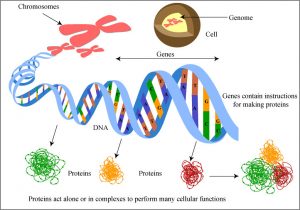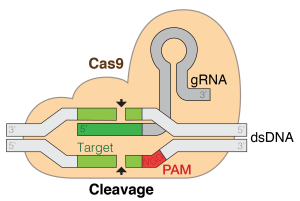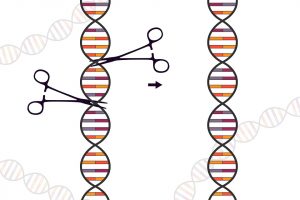18 Human Genetic Engineering
Melissa Nolan
18.1 Introduction
Keywords
- Gene – units of heredity transferred from a parent to offspring, contained in DNA
- Gene editing – deliberate manipulation of the genetic material to achieve desired results
- Human Genetic Engineering (HGE) – gene editing applied to human cells
- CRISPR/Cas9 – gene editing technology derived from bacterial immune system
- Germline gene editing – a process which alters the genome of an embryo, so that the entire organism has altered genes and can pass those genes down to offspring
- Somatic gene editing – a process which alters the genome of just a few cells in an organism, so that the altered genes are not passed down to offspring
- Recombinant DNA – genetic material from multiple sources
- Congenital disease – a disease present from birth, typically caused by some genetic factor
- Eugenics – the study of how to arrange reproduction within a human population to increase the occurrence of heritable characteristics regarded as desirable
- Technological determinism – technology determines the development of its social structure and cultural values or regulations
- Cultural determinism – the culture we are raised presents certain issues which necessitate the development of a specific technology
- Legacy thinking – using thinking strategies and actions which are outdated and no longer serve the purpose they once did
- Antibodies – proteins produced by an organism as a result of their immune response
Learning Objectives
By the end of this chapter, students should be able to:
- Understand the basic principles of gene editing and their applications.
- Understand the history of gene editing
- Identify potential ethical concerns regarding human genetic engineering
Those beautiful blue eyes you inherited from your mother are actually a result of a complex science known as Genetics. The scientific field of genetics studies genes in our DNA. Genes are units of heredity transferred from a parent to offspring and determine some characteristic of offspring. Your genes are responsible for coding all of your traits- including hair color, eye color, and so on. In recent years, scientists began exploring the concept of gene editing, which is the deliberate manipulation of genetic material to achieve desired results. Gene editing can potentially alter any given trait in an organism- from height to hair texture to susceptibility for certain diseases.
Gene editing applied to humans is referred to as Human Genetic Engineering, or HGE. There is extensive debate in and out of the scientific community regarding the ethics of HGE. Much of this debate stems from how this technology will affect society, and vice versa. Individuals may harbor concerns about the rise of “designer babies” or scientists “playing God” by determining the traits of an individual. On the contrary, HGE presents potential cures to diseases caused by genetic mutations. Human Genetic Engineering (HGE) is a novel technology which presents various ethical concerns and potential consequences. HGE should be approached cautiously and with extensive governmental regulation given it’s history, it’s current state, and the potential it has to change the world in the future.

“Genetic Encoding of Proteins” by MIT OpenCourseWare is licensed under CC BY-NC-SA 2.0
18.2 What is HGE
Key Takeaway
HGE encompasses a variety of methods which all work to produce a deliberate change in the human genome. The most common and prevalent way to edit the human genome is via CRISPR/Cas9. CRISPR stands for clustered regularly interspaced short palindromic repeats, and Cas9 is a protein that functions as scissors to cut DNA/genes. The CRISPR/Cas9 system originally developed as a part of a bacteria’s immune system, which can recognize repeats in DNA of invading viruses, then cut them out. Since then, scientists have harnessed the CRISPR/Cas9 system to cut DNA sequences of their choice and then insert new DNA sequences in their place.
The CRISPR/Cas9 system allows for designer genomes, and rapid engineering of any cell’s programming. With the use of CRISPR/Cas9, scientists can cut out certain traits from an individual’s cells and insert new traits into those same cells.

“CRISPR Cas9 System” by Marius Walter is licensed under CC-BY-SA-4.0
18.3 History of Gene Editing
Key Takeaway
Gene therapy concepts were initially introduced in the 1960s, utilizing outdated methods, such as recombinant DNA technology and viral vectors, to edit microorganisms’ genomes. Recombinant DNA consists of genetic material from multiple sources. The first experiments involved transferring a genome from one bacteria to another via a viral vector. Soon after was the first successful transformation of human cells with foreign DNA. The success of the experiment prompted public concern over the ethics of gene therapy, and led to political regulation. In the gene therapy report of the President’s Commission in the United States, germline genome editing was deemed problematic over somatic genome editing. Also, non-medical genome editing was deemed problematic over medical genome editing. Germline genome editing occurs when scientists alter the genome of an embryo, so that the entire organism has altered genes and the traits can be passed to offspring. Somatic genome editing involves editing only a few cells in the entire organism so that traits can not be passed down to offspring. In response to the report, the rDNA Advisory Committee of the National Institutes of Health was formed and proposed the first guidelines for the gene therapy clinical trials. This is an example of technological determinism, in which technology determines the development of its social structure and cultural values or regulations.
In the past few decades, gene editing has advanced exponentially, introducing state-of-the-art technologies such as the CRISPR/Cas9 system, which was developed to induce gene modifications at very specific target sites. Thus, gene editing became a major focus for medical research (Tamura, 2020). Gene editing has led to the potential for development of treatment strategies for a variety of diseases and cancers. So far, somatic genome editing has shown promise in treating leukemia, melanoma, and a variety of other diseases. In this way, HGE may be demonstrative of cultural determinism, in which the culture we are raised presents certain issues which necessitate the development of a specific technology.

“DNA CRISPR Scissors” by Max Pixel is licensed under CC0 1.0
18.4. Impact of HGE on society
Key Takeaway
Somatic genome editing in HGE via the CRISPR/Cas9 system has proven to be effective at editing specific genome sites. Since 2015, genome editing technologies have been used in over 30 human clinical trials and have shown positive patient outcomes. The treatment of disease may be a positive benefit of HGE, but there are also various potential risks. Various forms of deliberative democracies formed in recent years to address scientific and ethical concerns in HGE. Deliberative democracies affirm the need to justify technological decisions made by citizens and their representatives with experts in the field via deliberation. Overall, the consensus remains that the pros and cons of HGE are not equivalent enough to justify widespread use of the technology.
18.4.1 Pros of HGE
Current human clinical trials show successful transformation of human immune cells to HIV-resistant cells. This implies that HGE may be the cure for HIV(Hu, 2019). Other successful somatic genome editing trials treated myeloma, leukemia, sickle cell disease, various forms of epithelial cancers, and hemophilia. Thus, gene editing has provided novel treatment options for congenital diseases and cancers (Tamaura, 2020). Congenital diseases are those present from birth, and typically have a genetic cause. For these reasons, scientific summits concluded HGE is ethical for research regarding somatic genome editing in congenital diseases and cancers.
18.4.2 Cons of HGE
There are many safety concerns regarding CRISPR applications, mainly in germline genome editing. As a result of technological determinism, a leading group of CRISPR/Cas9 scientists and ethicists met for the international Summit on Human Gene Editing. The summit determined that heritable genome research trials may be permitted only following extensive research on risks and benefits of HGE. However, the summit concluded that federal funding cannot be used to support research involving human embryos with germline editing techniques. These decisions were made to avoid potential risks such as the following.
The major concerns regarding germline genome editing in HGE include: serious injury or disability, a blurry line between therapeutic applications of HGE and medical applications, misapplications, potential for eugenics ( the study of how to arrange reproduction within a human population to increase the occurrence of heritable characteristics regarded as desirable), and inequitable access to the technology.
18.5. Future Outlook
Key Takeaway
The future of HGE is uncertain and requires immense forethought. The American Society of Human Genetics workgroup developed a position statement on human germline engineering. The statement argues that it is inappropriate to perform germline gene editing that culminates in human pregnancy; and that in vitro(outside of an organism) germline editing should be permitted with appropriate oversight. It also states future clinical human germline editing requires ethical justification, compelling medical rationale, and evidence that supports its clinical usage. Many of these decisions were made based on the potential concerts over the future possibilities of the technology.
At the societal level, there may be concerns related to eugenics, social justice, and accessibility to technology. Eugenics could potentially reinforce prejudice and enforce exclusivity in certain physical traits. Traits can be preselected for, thus labeling some as ‘good’ and others as ‘unfavorable’. This may perpetuate existing racist ideals, for example.
Moreover, germline genome editing may also increase the amount of inequality in a society. Human germline editing is likely to be very expensive and access may be limited to certain geographic regions, health systems, or socioeconomic statuses. Even if human genetic engineering is only used for medical purposes, genetic disease could become an artifact of class, location, or ethnic group. Therefore, preclinical trials are necessary to establish validity, safety, and efficacy before any wide scale studies are initiated.
Others argue that HGE may lessen genetic diversity in a human population, creating a biological monoculture that could lead to disease susceptibility and eventual extinction. Analyses have predicted that there will be negligible effect on diversity and will more likely ensure the health and longevity of humans (Russel, 2010). Legacy thinking may be responsible for the hesitations towards continuing forward with HGE, as there are also many potential pros for genetic engineering. Legacy thinking is using outdated thinking strategies and actions which may not be useful anymore.
In an alternative modernity, we can imagine HGE as an end-all for most congenital diseases and cancers. Moreover, it may be used in germline gene editing to prevent certain birth defects or heritable diseases. So, although HGE has a variety of potential risk factors, there is also great promise for novel medical therapies in the coming decades. The continued use of this technology should be approached cautiously and with extensive governmental regulation, allowing for research regarding its medical applications only.
In 2016, germline gene editing was proven feasible and effective in chickens by leading researchers in genetic engineering, Dimitrov and colleagues. In this study, scientists used CRISPR/Cas9 to target the gene for an antibody/ immunoglobulin commonly produced in chickens. Antibodies are proteins produced in immune response. In the resulting population, the chickens grew normally and healthily with modified antibodies which conferred drug resistance. This study was the first to prove that germline editing is both feasible and effective.
Chapter Summary
HGE is a rapidly expanding field of research which presents novel possibilities for the coming decades. HGE utilizes CRISPR/Cas9 gene editing tools to cut out specific genes and replace them with a newly designed gene. As important as this technology is, it is also important to recognize how new it is. Gene therapy research began in the 1960’s, with somatic cell editing only commencing in the past two decades. This has presented many advantages for the potential treatment of congenital diseases, but also presents various risks. Those risks stem from germline gene editing and include eugenics and inequitable access to the technology creating large socio economic divides. In the future, more regulation should be placed on the advancement of HGE research before larger-scale studies take place.
Review Questions
1. What is the primary technology proposed for use in HGE?
A. Recombinant DNA technology
B. CRISPR/Cas9
C. Bacterial Transformation
D. Immunoglobulin
2. When was gene therapy concepts first introduced?
A. 1920s
B. 1940s
C. 1960s
D. 1980s
3. What is a major ethical concern regarding HGE addressed in this chapter?
A. Potential for ageism
B. Gene editing is only 50% effective
C. HGE can only be used in Caucasians
D. Potential for eugenics
Answers:
- B
- C
- D
Food for Thought
- Would you personally employ germline genome editing for your own children? In what scenarios? Why or why not?
- Should technologies such as this be federally regulated or should scientific freedom preside? Justify your reasoning.
References
Baltimore, D. et. al.(2015). A prudent path forward for genomic engineering and germline gene modification. Science. https://doi.org/10.1126/science.aab1028
Brokowski, C., & Adli, M. (2019). CRISPR Ethics: Moral Considerations for Applications of a Powerful Tool. Journal of Molecular Biology. https://doi.org/10.1016/j.jmb.2018.05.044
Cong, L., Ran, F., & Zhang, F. (2013). Multiplex Genome Engineering Using CRISPR/Cas9 Systems. Science. https://doi.org/10.1126/science.1231143
Dimitrov, L., et. al. (2016). Germline Gene Editing in Chickens by Efficient CRISPR-Mediated Homologous Recombination in Primordial Germ Cells. Plos One. https://doi.org/10.1371/journal.pone.0154303
Hu, C. (2019). Safety of Transplantation of CRISPR CCR5 Modified CD34+ Cells in HIV-Infected Subjects with Hematological Malignancies. U.S National Library of Medicine. https://clinicaltrials.gov/ct2/show/NCT03164135
Ormond, K., et. al.(2017). Human Germline Genome Editing. AJHG. https://doi.org/10.1016/j.ajhg.2017.06.012
Russell P.(2010) The Evolutionary Biological Implications of Human Genetic Engineering, The Journal of Medicine and Philosophy: A Forum for Bioethics and Philosophy of Medicine. https://doi.org/10.1093/jmp/jhq004
Tamura, R., & Toda, M. (2020). Historic Overview of Genetic Engineering Technologies for Human Gene Therapy. Neurologia medico-chirurgica. https://doi.org/10.2176/nmc.ra.2020-0049
Thomas, C. (2020). CRISPR-Edited Allogeneic Anti-CD19 CAR-T Cell Therapy for Relapsed/Refractory B Cell Non-Hodgkin Lymphoma. ClinicalTrials. https://clinicaltrials.gov/show/NCT04637763
Units of heredity transferred from a parent to offspring, contained in DNA.
Deliberate manipulation of the genetic material to achieve desired results.
Gene editing applied to human cells.
Gene editing technology derived from bacterial immune system.
genetic material from multiple sources
A process which alters the genome of an embryo, so that the entire organism has altered genes and can pass those genes down to offspring.
A process which alters the genome of just a few cells in an organism, so that the altered genes are not passed down to offspring.
The idea that a society's technology determines the development of its social and cultural values.
The culture we are raised presents certain issues which necessitate the development of a specific technology.
A disease present from birth, typically caused by some genetic factor.
The study of how to arrange reproduction within a human population to increase the occurrence of heritable characteristics regarded as desirable.
Using thinking strategies and actions which are outdated and no longer serve the purpose they once did.
Proteins produced by an organism as a result of their immune response,

